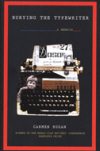Burying the Typewriter
Not many memoirs approach the act of resisting a totalitarian regime through a child’s eyes. But then, reading Carmen Bugan’s Burying the Typewriter is an unusual experience.
Not many memoirs approach the act of resisting a totalitarian regime through a child’s eyes. But then, reading Carmen Bugan’s Burying the Typewriter is an unusual experience.
The author’s family entered exile in the U.S. a mere month before Romania’s Communist president, Nicolae Ceau?escu, was overthrown in 1989. Bugan describes her childhood before and after her father staged a one-man protest in the middle of Bucharest in 1983. She reveals what it was like to discover her father’s resistance activities and then to survive the resulting persecution orchestrated by the Securitate, Communist Romania’s secret police. First, however, she sets the stage.
Looking back at photos from that time, she says, “Though everything is in black and white, I remember the colors of the clothes and the dusty green or the sandy green of vacations. . . . They are passageways back in time.” Bugan takes us back, conjuring rich sensory details of everyday life in her village: her grandfather’s horse and cart moving slowly up a dusty road, the rituals of holidays—preparing cakes, the blessing of the house, slaughtering the pig, carolers’ costumes. She recalls her heart exploding “with happiness and colors.” At the birth of a chick at her grandparents’ farm she says, “I go and watch forever until the shell begins to crack and pieces of it fall on the grass, revealing a tiny beak, and then the chick, astonished with life.”
Her own astonishing life requires maturity early on, as critical events accelerate her coming of age. First the March 1977 earthquake, in which buildings in Bucharest collapsed and thousands of people were killed or wounded: “For the first time I understand that the earth is weak and can slip from under me.” Her maternal grandmother suffers a stroke and dies: “Keening is a ritual that blends weeping with singing, the sonorous with the throat-squeezed, hiccupped farewell. Mourning is a gentle release of pain through a song,” she explains, imagining that “poetry is a little like keening, too. The best poems pause on the sob in your throat, weeping both for what is beautiful and for what is lost to darkness and evil.” At her parents’ grocery story, Bugan and her sister distribute rations to desperate people in all-day lines. This obvious scarcity contradicts the abundance taught in school: “At the end of the bread hour many people go home empty-handed, and I see under the window fallen buttons from overcoats, lost scarves, dropped change, all stamped in the black, dusty earth.” The author begins to sense that there is a world of secrets underlying her family’s existence. Too many questions go unanswered, and clicks from her father’s illegal typewriter increase at a furious pace. Finally, she and her sister stumble upon “a stack of typed-up pamphlets, hidden between an old fridge and [their] bicycles. The text there reads: ‘We ask for human rights. We ask for freedom of opinion. We ask for hot water and electricity. We ask for freedom to assemble.’” Her suspicions are confirmed.
Soon thereafter, her father is imprisoned for Propaganda Against the Socialist Regime. She and the family are subject to 24-7 surveillance. Securitate not only takes up residence in their home, but agents haunt the village, interrogating neighbors and friends, strong-arming them to inform on the Bugans. At this horrific period of her adolescence, the author leans heavily on poetry and literature, losing herself in characters whose lives “do not reflect [her] daily existence, so reading is a kind of escape from one life into another.”
After several years in prison, Ion Bugan is granted amnesty and released to house arrest in the family home. With this new “freedom,” however, he develops both the physical and psychological pallor of a caged animal. Meanwhile, questions continue to “hover over painful silence.” Did he have regrets? Was it worth subjecting his family to such an ordeal for the sake of a whole country?
When they receive middle-of-the-night death threats, the family makes the painful decision to seek political asylum. The author herself approaches the American Embassy in Bucharest to request international protection and to declare the family’s intent to emigrate.
“Sometimes it takes sacrificing a family for a country,” Ion Bugan would eventually tell his daughter. And she would tell us readers to never mind her feelings about such a reply. “It is better not to judge; it is better to try to understand, to observe. Judgment can be dangerous in situations such as these.”
This may be true, but it’s a little like telling the moth to ignore the porch light. How can a reader “never mind” the feelings of a memoir writer? Reflection and the now-perspective, after all, are the glues that bind memoir. Warm and full of grace, Carmen Bugan’s lyrical then-perspective may hold you in thrall, but sooner or later, you can’t help wonder about the missed opportunity to mine her childhood for further revelation. Unless . . . perhaps a follow-up memoir waits to be unearthed.





